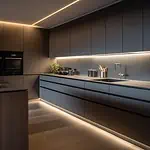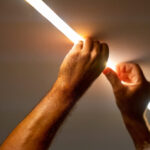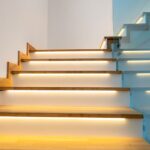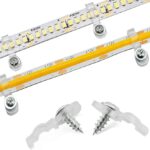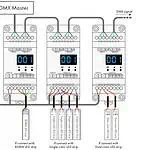Are you in a dilemma about installing and using LED strip lights? No more worries; this guide will help you!
LED strip lights are one of the most versatile light fixtures you can use in multiple ways. They come with adhesive backing that makes the installation process super easy. All you need to do is cut the strips, remove the adhesive tape, press it on the surface, and power it up. That is it! However, you can also use clips or aluminum channels for installation.
This article will provide a complete guide for installing LED strip lights, their uses, common mistakes when installing, and more. So, without any further delay, let’s jump into the discussion.
Purpose Of Using LED Strips
LED strip lights are super flexible, highly cost-effective, and available in several variants. All these features make them an ideal option for different types of lighting purposes; these include-
General Lighting
General lighting refers to the room’s overall lighting that provides sufficient visibility. LED strip lights’ soft and indirect illumination makes them ideal for this purpose. You can use them for general lighting of your house, office, hotels, restaurants, and more. Cove lighting with LED strips is a popular option here!
Task Lighting
LED strip lights are also a popular option for task lights thanks to their adjustable lighting features. You can use them on your study table, cooking station, working desk, and more. LED strips are, in fact, best for vanity lighting. You will find them on the mirror of barber shops and beauty parlors, aiding proper mirror views. To learn more about mirror lighting, check this- How To DIY LED Light Strips For Mirror?
Accent Or Mood Lighting
Accent lighting highlights any specific features or space to create special effects. LED strip lights are the perfect choice for the Bedroom, dining room, reading room, and living room lighting. You can create special moments or environments with the help of accent or mood lighting.
Decorative Lighting
Decorative lighting is the most popular at present time. LED strip lights are the first choice for all types of decoration lighting for their high efficiency and unique color intensity. Using these lights, you can create extra glowing and brightness at any national or social festival.
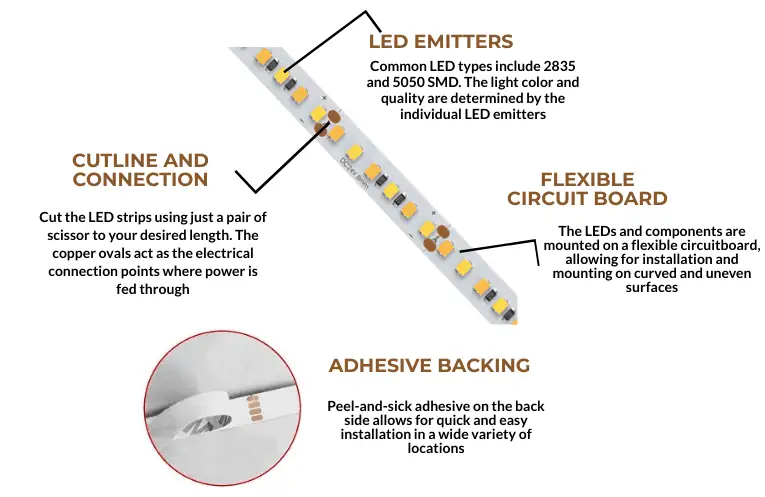
Things You Should Know Before Installing LED Strips
Before choosing LED strips for your space, here are some facts that you should consider-
How To Choose The Right LED Strip?
LED strip lights are easy to use and install. However, choosing the right LED strips is time-consuming and challenging. So, here I listed some points to help you out-
Types Of LED Strip
There are different types of LED strip lights in the market. These are-
Single-color LED strip lights are also known as monochromatic LED strips. This variety of LED strips is perfect for cabinet, deck, general lighting, and accent lighting.
The tunable white LED Strip light is designed with an adjusted color temperature. Using these fixtures, you can change the color of the light from dim to warm. They usually come in two variants- 1800K-6500K or from 2700K-6500K color temperature (CCT). Check this article to learn more about tunable LED strips- Tunable White LED Strip: The Complete Guide.
Dim-To-Warm LED strips create a perfect, customized, wonderful look. These are excellent for bedroom lighting. The warm illumination of these lights further aids you in good sleep. To know more, check this- What is the Difference Between Dim to Warm LED Strips and Tunable White LED Strips?
RGB contains the primary three colors: Red, Green, and Blue. Using these fixtures, you can create about 16 million hues! There are many more variants of RGB lighting. To know about them, check this guide- RGB vs. RGBW vs. RGBIC vs. RGBWW vs. RGBCCT LED Strip Lights.
You can change the entire lighting game of your space by installing digital color-changing LED strips! These lights come with IC chips that allow you to control the lighting of each segment of the strips. These lights are also known as addressable, magic, or dream color LED strips. Wanna know more about it? Check this- The Ultimate Guide To Addressable LED Strip.
- Motion Sensor LED Strip
Motion Sensor LED strip lighting is a perfect choice for making your home smart living and energy-saving. These fixtures come with motion detectors that identify the movement of any person/object and respond accordingly. This not only gives a high-tech sense but also saves you electricity bills.
LED Density
LED Density refers to how many LEDs are used in every meter or foot. The higher density LED strip means more lights for brighter lighting output. A low-density LED strip won’t glow as bright as the one with more LEDs.
SMD
The term SMD is used in the LEDs along with four-digit numbers to indicate the size of the LED chips. The lighting output of the LED strips greatly depends on the size of the chip. For more information, this article will help you- Numbers and LEDs: What Does 2835, 3528, and 5050 Mean?
IP & IK Ratings
IP ratings refer to Ingress Protection. It indicates the level of protection from any solid and liquid ingress. Two common categories of IP ratings are used for the LED lighting industry. The indoor IP ratings are IP22, IP44, and IP54. The other IP ratings are IP65, IP66, IP67, and IP68. On the other hand, IK ratings refer to the impact resistance level of the protection from mechanical effects. To know more about the IP and IK ratings, check this- IP Rating: The Definitive Guide IK Rating: The Definitive Guide.
Color Temperature
The color temperature of the lighting can greatly impact the ambiance of your space. Warm lighting has a low color temperature that gives a dim and cozy impression. Meanwhile, the cool lights have higher color temperatures for more refreshing lighting output. The color temperature of LED strips usually ranges between 2700K-6500K. For 2000K-3500K, the lighting will be warm and cool for 3500K to 5100K.
CRI
Color Rendering Index (CRI) is the industry standard for measuring the ability of a particular light’s accuracy. It is measured with a scale which goes up to 100. The CRI measurement is an important factor for determining the performance of the LED strip lights. Always choose strips with CRI 80 or above for better results.
LED Strip Mounting Techniques
LED strip lights are popular for their easy installation. In this section, I will let you know about three mounting techniques following which you can install these strips like a pro. These include-
- Adhesive mounting
Adhesive mounting is the most simple and quick process of all techniques. Remove the double-sided tapes and press them to the installation surface, and it’s done!
- Clip mounting
Clip mounting is a stronger and more reliable process than the adhesive method. This method applies clips for mounting on the surfaces. There are different types of clips available in the market. These include- one-side bracket fixing clips, angle adjust clips, clips with adhesive backing, and e-clips.
- Channel mounting
You can install the LED flex strips following channel mounting. Channel mounting protects the LEDs from environmental damage. This method provides the perfect and unique visible results for both commercial and residential mounting. To gather an overall idea about LED flex mounting, read this- Installing LED Flex Strips: Mounting Techniques.
How To Cut LED Strips?
LED strips come with tape or rope structure in a 5-meter reel. But what will you do if you need less than 5 meters? No worries, LED strips are cuttable! You will find scissor icons on the PCB after a few intervals. These icons indicate cutting points. You can quickly size the LED strips, cutting them into those designated spots. For detailed guidelines, check this- Can You Cut LED Strip Lights and How To Connect: Full Guide.
How To Rejoin Or Connect Multiple LED Strips?
After cutting the LED strips, sometimes, any part may be shorter or larger than the desired sizes. In this case, you must cut and reconnect them again to get the right length. You can do this in two ways-
- Using LED strip connectors
- Soldering
LED strip connectors give you a quick and easy solution to rejoin LED strips. But the joining points may loosen over time. That is why I suggest you go for soldering if you want a more stable connection. However, strip connectors are also good if you can use them correctly.
How To Power LED Strips?
The LED strips require a power source to glow. Besides the plugin, there are more options to power up the LED strips. These include- battery power, USB power, solar energy, etc. But whatever the option you choose, considering the voltage is crucial. For optimal output, the voltage of the power source must match the voltage of the LED strips. Again, maintaining the polarity is a must. Ensure the LED strips’ positive ends are connected to the positive end of the power source and vice versa. Besides, the voltage of your LED strips should match the voltage of the power source. For details, pitch this- How to Cut, Connect, and Power LED Strip Lights.
From Where To Source LED Strips?
You can get LED strips from both local markets and online stores. But regarding bulk quantity, I suggest you contact any professional LED strip light manufacturer and supplier. China is your best option to source LED strips. You will find high-quality LED strip lights at affordable prices. But where to find them? No worries, check out this guide- 10 Steps to Find a Professional LED Strip Supplier In China. But all light fixtures in China are not equally reliable. You need to know which companies to choose. So, check this article for the best option for you- Top LED Strip Light Manufacturers And Suppliers In China 2023.
However, if you are new to this business and don’t know how to source LED strips, go through this article- Are You Making These Common Mistakes When Sourcing LED Strip Lights?
What Issues You May Face When Using LED Strips?
You may face issues using any light fixture; the same goes for LED strip lights. Yet, I’m adding the most common problem that you may account for
- Flickering issues
- Difference in light color
- Brightness inconsistencies
- Voltage problem
- Overheating of the strips, etc.
If you face any of the above issues while using LED strips, check this guide to find a quick solution- Troubleshooting LED Strip Problems.
How To Install LED Strip Lights?
Step 1: Select Location
First, choose the location where you will install the strip lights. Consider if the location is indoor or outdoor. This will help you in choosing the right LED strip and mounting technique.
Step 2: Gather Necessary Materials
Once you have decided on the location, collect the necessary materials. Here is what you will need-
- Measuring tape
- Scissor
- LED strip connectors
- LED controller
- LED driver
However, you may use clips to ensure the strips don’t fall off. And if you choose to mount them following the channel method, purchase aluminum channels. For the best quality, check out LEDYi LED Aluminum Profile.
Step 3: Take Measurements & Size The Strips
When you have collected the necessary tools, measure your locations’ perimeter and the stripes. The LED strip lights are adjustable, so you can custom install them for various lengths. Usually, the LED strip comes in a 5-meter reel. If your requirement is less than this, you can easily cut them off.
Step 4: Clean The Surface
To ensure the LED strip seats firmly on the surface, ensure it is clean enough. In this case, you can use wet clothes. But the place must be completely dry. If you install the LED strips on a wet surface, they won’t stick properly. Moreover, water contact can be very risky for electrical equipment.
Step 5: Mount The LED Strips
Now, take the LED strips and mount them to your desired surface. Remove the adhesive backing and firmly press it to the surface. For additional safety, you can use clips. However, if you want aluminum channels, this guide will help you- Ultimate Guide To Aluminum Profile For LED Strip.
Step 6: Power It Up
Finally, it’s time to power them up. If you are using low-voltage LED strips, you will require a driver. Check the electric source’s positive(+) and negative(-) marks and connect them accordingly to your LED strips. Turn on the switch and watch your LED strips glowing!
Common Mistakes While Installing LED Strips
LED strip lights are 85% power-saving, flexible, reliable, and durable. But if you make any fault in installation, you will get a poor lighting experience. Check the below points to find out the common mistakes to avoid during the installation process-
- Selecting the low-quality and wrong types of LED strips
- Inaccurate measurement of the surfaces and the strips.
- Wrong cutting of the strips without following the cutting icons and points.
- Improper installation like wrong connection, loose problem, incorrect reconnection of the strips after cutting.
- Avoiding environmental factors such as UV rays, heat, dirt, water, etc.
- Overlooking the dimmer problem and avoiding the control options.
- Using low-quality attachments while installing.
- Choosing the wrong voltage LED strips that don’t match the power source
However, if you make any of these mistakes, don’t panic. Read this- 10 Common Mistakes to Avoid When Installing LED Strip Lighting, to find a quick solution.
Creative Ways To Use LED Strip Light
You can customize LED strips in various colors, shapes, and sizes for creativity. Let’s see the below sections for more details about the creative uses of the LED strip lights.
- Ceiling Lighting
Nothing can beat cove lighting techniques when it comes to ceiling lighting with LED strips. It creates a soft indirect illumination that fits both residential and commercial usage. To learn how to install these strips to your ceiling, check this- How To Install LED Strip Lights on the Ceiling?
- Bathroom Lighting
A well-planned bathroom lighting is equally important with other lighting in your home. You can install LED strips for the general lighting of your bathroom. Besides, installing them around the mirrors, bathtub, and niches also looks great. For more bathroom lighting ideas, check this- Top 26 Creative Bathroom Lighting Ideas.
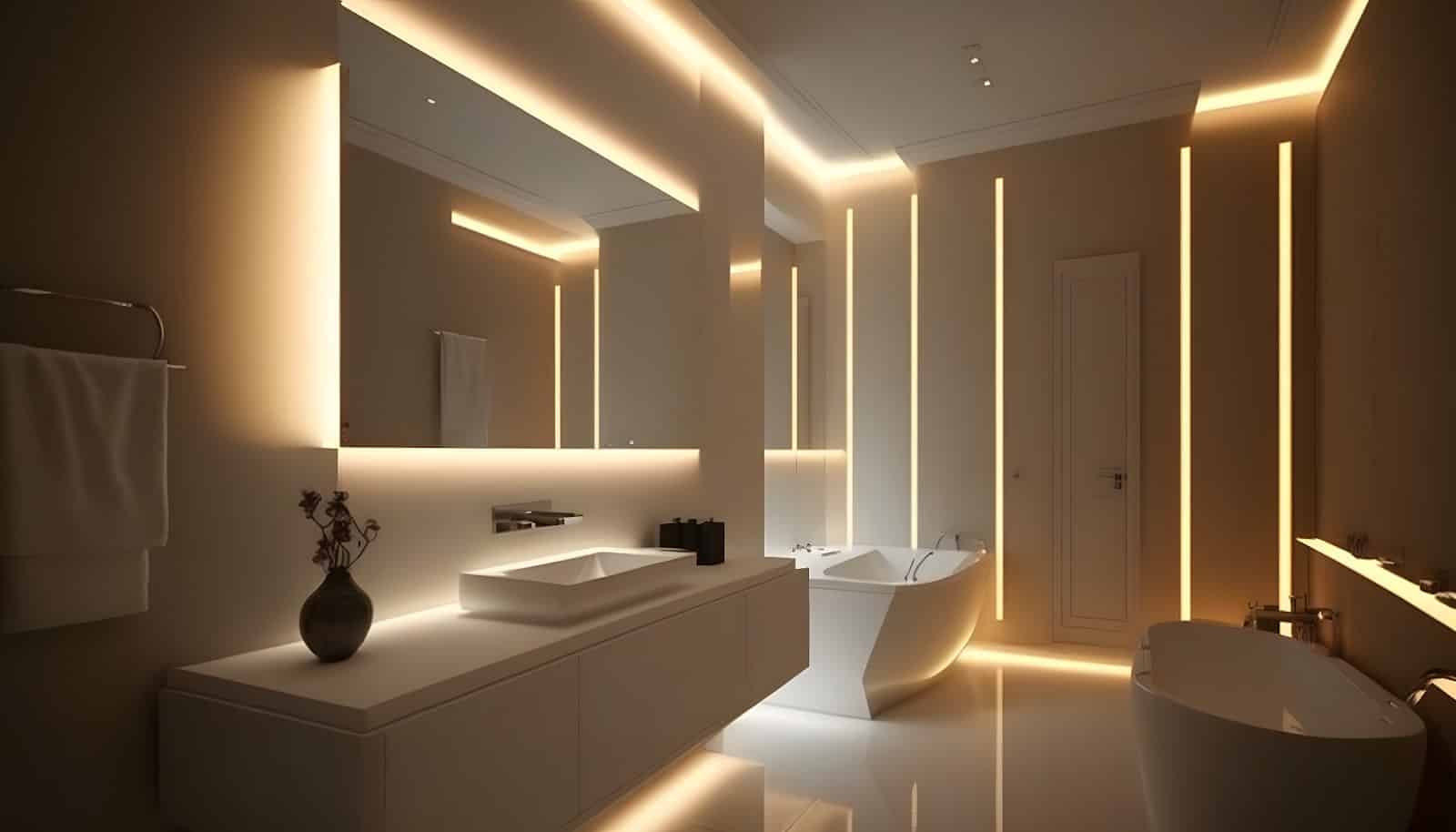
- Bedroom Lighting
Tunable white LED strips and dim-to-warm LED strip lights are the best choices for your Bedroom. However, if you want to choose single-color LED strips, use a warmer tone, as low-color temperature lights are good for your strip. Besides, you can also use RGB LED strips for more colorful options. Want to know more? Check this article- 35 LED Strip Ideas for the Bedroom.
- Boat Lighting
If you want to float in the magical paradise, install LED strip lights on your boat. In this case, IP rating is the most crucial factor to consider. However, this will vary depending on the area of the boat where you are installing the fixture. For instance, for lighting up the boat cabin, LED strips with IP64 or 65 will work. But if you are aiming for underwater lighting, IP68 is a must. For details, check this- How To Install LED Strip Lights On a Boat?
- Stairway Lighting
You can use LED strips to light up both indoor and outdoor stairs. Install them on the steps, along the railing, and more to bring an aesthetic outcome. However, you can check our super long LED strip series for lighting up your stairs- Constant Current LED Strip. Go through this article for more stair lighting ideas- 16 Stair Lighting Ideas With LED Strip Lights.
- Commercial Space Lighting
Commercial lighting has different lighting requirements than residential lighting. You must consider purchasing LED strips with higher IP and IK ratings for these areas. For more detailed information, read this guide- Commercial Lighting: A Definitive Guide.

- Office Lighting
Do you know warm lighting can make employees feel lazy and thus decrease productivity? That is why always choose cool LED strip lighting for working stations in your office. Necterless, you can use warm lighting in the reception, bathroom, or waiting room of your office. Go through this article for details- Office Lighting: The Definitive Guide.
- Hospital Lighting
The lighting requirements of the hospital vary for different zones. For instance, choose cool white LED strips if you are lighting a doctor’s chamber. Again, for the patient chamber, warm lighting will work ok. There are more lighting facts to consider for hospital lighting. Read this to learn about Hospital Lighting: Why Choose LED Lights?

- Outdoor Lightings
You can install LED strips to illuminate the front door of your building, parking lot, etc. For more ideas, read 34 Outdoor Lighting Ideas for Front of House. However, note that outdoor lights face harsh weather conditions like rain, dust, storms, etc. So, you must choose robust LED strips for this area.
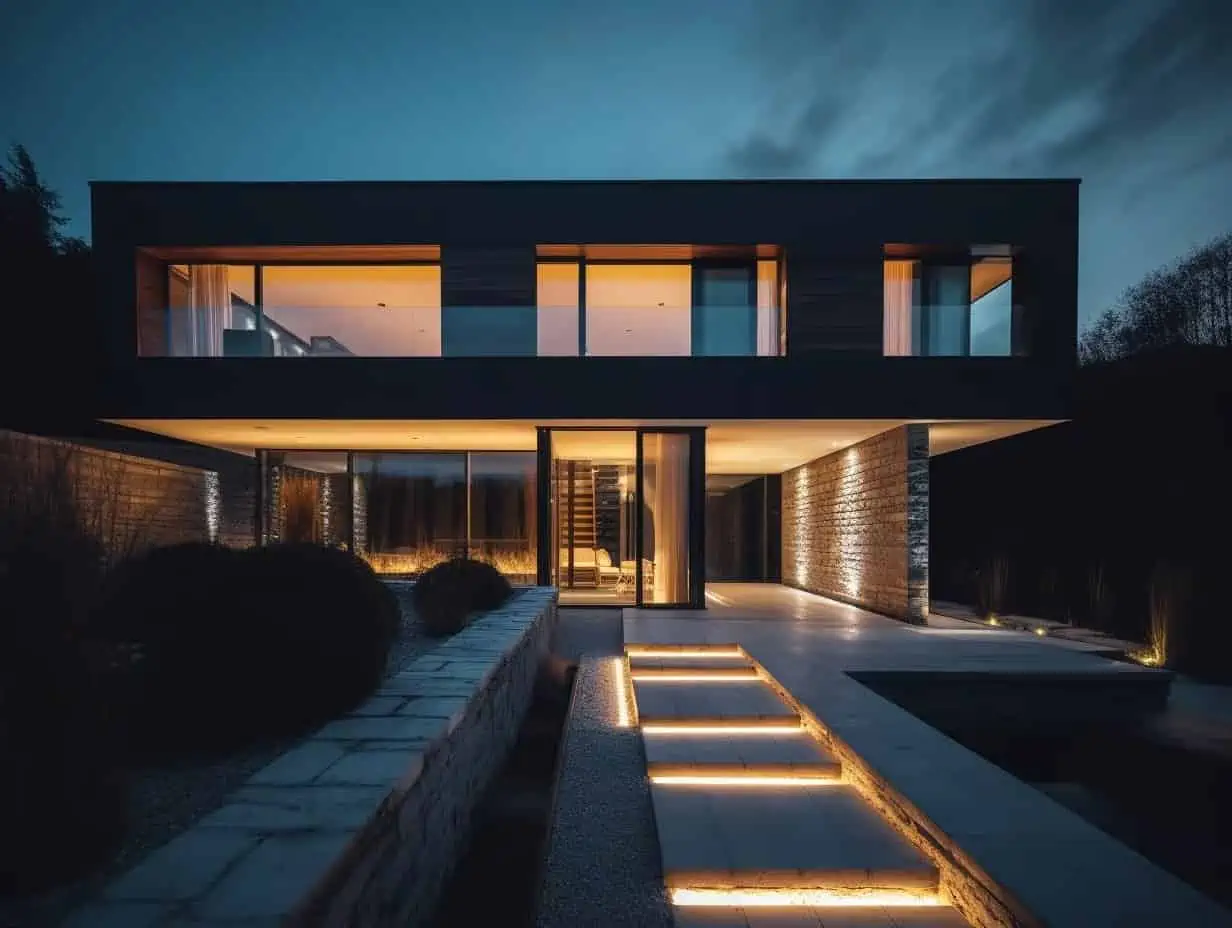
FAQs
LED strip lights come with easy-install technology. That’s why you don’t need any professionals to install them. However, having a professional electrician to ensure proper outdoor and larger commercial installation is better.
Absolutely not. LED strip lights are highly energy efficient. They use 80% less energy than traditional lighting, like incandescent. Besides, they don’t get overheated easily and also last longer.
Yes, you can. LEDs can run continuously 24/7 without overheating. The LED strip lights convert 85%-90% of energy as light and 15%-10% to heat. For this feature, you can leave your LED strip lights on all night with a rare chance of fire.
LED strip lights come with adhesive backing that is quick to install. Simply peel off the tape and press it on the wall- your LED strips will get stuck!
Yes, you can connect the LED strip light with a battery. Select the batteries that match the LED strip light’s voltage. Connect the strip’s positive (+) sign end with the battery’s (+) sides and vice versa. Add the battery’s positive terminal with the strip’s positive terminal and the negative terminal with the negative terminal. Then, connect the LED strip lights with the controller’s V+, R, G, and B marks to power up.
Select the desired voltage strip lights that match the power supply voltage. Then, connect the positive terminal of the strips with the power source’s positive terminal and the negative power terminal with the negative power terminal. After connecting, turn on the switch for lighting up. If the lights don’t turn on, check the connection and fix it.
The Bottom Line
The most impressive fact about LED strips is that you need not be a professional electrician to install them. They come with adhesive backing that makes your task easier. Besides, these super flexible fixtures are ideal for residential and commercial needs.
However, if you want the best quality, LEDYi is your best option. Besides LED strip lights, we also have LED strip connectors and LED drivers, LED controller, LED aluminum profile, and more. In short, you provide all the essentials required for LED strip light installation. So, contact us ASAP!
